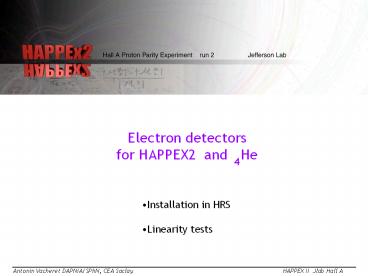Electron detectors for HAPPEX2 and He - PowerPoint PPT Presentation
Title:
Electron detectors for HAPPEX2 and He
Description:
Installation procedure to be tested next week in the Hall. Coordinate with installation of scanners. Antonin Vacheret DAPNIA/SPhN, CEA Saclay. ... – PowerPoint PPT presentation
Number of Views:19
Avg rating:3.0/5.0
Title: Electron detectors for HAPPEX2 and He
1
Electron detectors for HAPPEX2 and He
4
- Installation in HRS
- Linearity tests
2
Detectors
3
Installation
Installation procedure to be tested next week in
the Hall
Coordinate with installation of scanners
4
Linearity and Asymmetry
- Output signal of the PMT
- Asymmetry measured
The nonlinear term is proportional to the signal
amplitude.
- HAPPEX requirement
5
Mode of operation of the tube
- Integrating mode
- High beam intensity (80 100 mA)
- Rate in HRS t 50 MHz in the whole detector
- Low gain region
- Continuous signal less than 6 mA to match ADC
range - Pulse mode
- - Background study and Q2 measurement
- Low beam intensity (factor 200 less counting
rate to fire VDCs) - Rate in HRS t 10 KHz/cm2
- High gain region
- pulse signal of a few mA
- need large dynamic range and good
linearity capability
33 ms
6
PULSE mode linearity setup
Method
Blue LED (430 nm)
-HV
Att dB
Att dB
8854 BURLE PMT
Deviation from linearity
ADC
Remote Filter wheels
Pulse generator
La
Lf
Normalization (1st order)
S(La)
S(Lf)
Ped
Light flux
PMT response
7
PULSE mode linearity
Active base
Resistive base
2
2
Operating range
250
250
Nge-
Nge-
- Non linearity at high gain due to saturation in
latter dynodes - operating range is in a good
linearity region
8
Linearity in continuous mode setup
Shutter 1
Method Use of additivity
Shutter 2
-HV
Micro Amperemetre
DC voltage
Plans to implement this method online for the
HAPPEX-2 run
9
Linearity in continuous mode
Resistive base
Active base
ADC range
2
Results for average continuous current Is the
pulse structure still relevant ? Evaluation of
the real output current is done with a duty
factor of 2 or 3
10
Gain drift
Measurement of Drift in gain with a pulse signal
and a load of continuous light background of 1,
5, 15 mA
Load ON
Load OFF
Gain do depends on output current but timescale
very long. no systematics from rate-gain
correlation at 30 Hz
11
conclusion
- Complete tests of linearity for the BURLE 8854
base - Resistive base H gain G
1E6-3E6 output 2-8 mA L gain G
5E3-1E4 output 10-20 mA filters
(0.5,0.2,0.1) - Active base H gain G
1E6-1E7 output 2-20 mA L gain G
1E4-2E4 output 20-40 mA filter (0.1)































